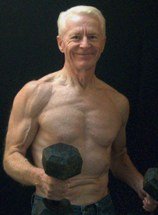| Back to Back Issues Page |
 |
|
The Gray Iron Fitness Newsletter, Issue #164 The Deck of Cards Butt Kicker June 15, 2015 |
Hi
June 15, 2015
In this newsletter . . . The Deck of Cards butt kickerCalling all supplement users
The Deck of Cards butt kickerIt's been 11 years since I last tested myself by doing the Deck of Cards workout. It is a butt-kicker, and in a minute I’ll tell you how it works. But first, it's important to know it is not a test for beginners. Beginners should start their training with something specifically for them.But for those ready to test themselves, do the following: Get a deck of playing cards. Assign an exercise to each suit. I assigned them as follows:
Shuffle the deck several times. Place the deck face down. Start your stopwatch or timer. Turn over the first card. Let’s say it’s a seven of hearts. Clean & Press your dumbbells seven times. Turn the next card. Suppose it’s a nine of spades. Do nine body-weight squats. With each card, do the same number of reps as the number on the card. The face cards are considered tens. Aces are eleven. Remove the jokers or keep them and assign them any number you want to. (I remove the jokers.) Keep going through the entire deck. Then check your stopwatch. Write down the time for your record. The idea is to go through the deck as fast as you can. If you do it that way, it’s a test—and butt kicker. Of course, the workout is not so difficult if you casually go through the deck. In shape athletes do the workout in less than 30 minutes. The training is supposed to be popular with Japanese wrestlers and judo competitors. But they often confine it to two exercises, such as squats and pushups. I like to do it with four. How did I do, personally? The first time I tried it took me 27 minutes. Then when I tested in 2003, I did it in 20:53.79. However, I used a different exercise mix, which may or may not have been less taxing. I tested twice in 2004, finishing once in 21:27.75 and once in 22:22.25. Though the exercise mix was slightly different each time (meaning there is some degree of “comparing apples with oranges”), there is no denying that I’d lost a step or two. Age happens. But I was still under 30 minutes. I’ve since done the deck of cards routine as a workout. But it’s been 11 years since I used a stopwatch and gave it everything I had. This is not a recommended test for beginners. If you like the newsletter, we're making it easy to share it . . . Calling all supplement usersDo you take any food supplements? Any vitamins, herbals, protein powders or diet pills? Most of us take at least one or two. Some take several. The supplement business is big business. It’s estimated that in America we spend about $30 billion a year on things like Echinacea, gingko biloba, St, Johns Wart, whey proteins, vitamins, and Lord knows what others. We aren’t alone. Other modern nations are similarly attracted.Are we getting our money’s worth? Not everyone thinks so. Here’s one source: According to the SCAN Health Plan, an HMO with a Medicare contract, several studies showed results that are troubling, to say the least. Consider the following:
Full disclosure: I don’t personally know who tested the supplements. And not all studies we read about are valid and unbiased. However, I can say that I have found the SCAN Health Plan people highly reputable. Disseminating findings that haven't been checked out would be out of character. I subscribe to ConsumerLab, an independent laboratory that tests a wide variety of supplements. Some products, though not a majority, fail their testing for not having the claimed ingredients; and some fail because they contain foreign—and sometimes dangerous—substances. ConsumerLab gives the names of those that pass or fail and why. Since there is scant oversight of the supplement business, I don’t how you and I can truly know what we’re buying, unless an independent laboratory tests the products and reports their findings. And I stress the word independent when talking about laboratory testing. My further thoughts about supplements are here. 
Newsletter Policy The Gray Iron Fitness Newsletter is a free publication sent twice monthly to subscribers. The purpose is to provide honest and realistic fitness information for people age 50 and above. I have never been paid or received compensation of any kind to write a positive review or endorse a product. If I say that I personally use a product or service, it is because I find value in it and have paid for it with my own money. Like newspapers, magazines and television, this newsletter and my web site contain advertising and marketing links. Naturally, I am compensated for these. The newsletter and web site provide information to help users establish and maintain a fitness lifestyle. But fitness information is not the same as fitness advice, which is the application of exercise and dietary practices to an individual's specific circumstances. Therefore, always consult with your physician for assurance that fitness information, and your interpretation of it, is appropriate for you. Your comments and questions are always appreciated. Simply click on the "Reply" bottom. |
| Back to Back Issues Page |